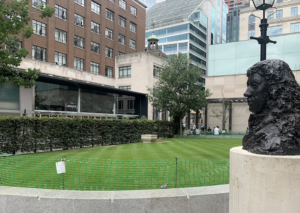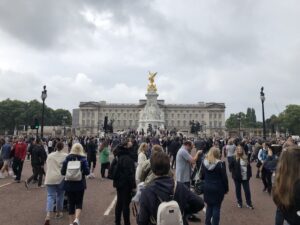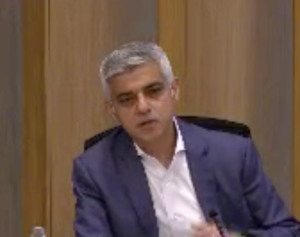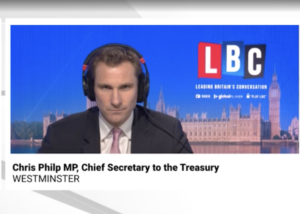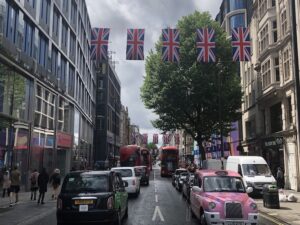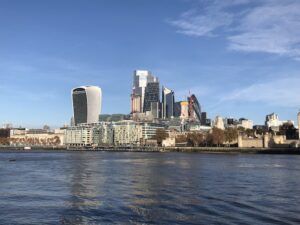London is blessed with small spaces covering up layers of history. They are often former plague pit sites, though few are as intriguing as the oasis of greenery in the City shown above, which would fetch a small fortune if sold to developers. This was the land of Samuel Pepys, subject of the bust on the right.
Pepys lived, wrote, worked, played and worshiped in the area covered by this photo for 12 years from 1660 after he was appointed Clerk of the Acts, a position originally called the Keeper of the King’s Ports and Galleys. It lies between Seething Lane and Crutched Friars. Pepys is also buried in this area, in St Olave’s church, along with his wife Elizabeth. The spire of the church can be seen peeping up in the background of the photo.
“Seething” didn’t mean boiling with rage in those days but “full of chaff”, the chaff in question generated by the nearby corn market in Fenchurch Street. Crutched Friars is a corruption of cruciferi and referred to the crosses sewn on the habits of the mendicant friars in the adjacent monastery, after whom the road is named.
Pepys lived in a dwelling on the left side of the newly created Navy Office, shown below, working night and day – including the nine years he wrote his famous diary – as he steadily rose in seniority, reforming the navy as he went along, not least by opposing the rapacity of contractors. He is rightly thought to be one of the founders of the modern navy.

The Pepys diaries are a unique eyewitness account of how one man lived in an era of huge political and social upheaval, taking in the Restoration of Charles II in 1660, the Great Plague of 1665, the Great Fire of London the following year, and the Second Anglo-Dutch War.
The 1665 plague was the darkest period for Seething Lane. It is reckoned that an astonishing 300 plague victims were buried in the churchyard, which led Pepys to remark: ‘‘It frighted me indeed to go through the church…to see so many graves lie so high upon the churchyard, where many people have been buried of the plague.” It also “frighted” Charles Dickens, who named the church “Sir Ghastly Grim” because of three skulls which still hang over its side entrance.
One of Pepys’s Seething Lane neighbours was Sir William Penn, whose amazing son, also named Willam Penn, was educated around the corner at All Hallows church. William Jnr went on to found the US state of Pennsylvania, which the Crown bestowed on him after Charles II’s death in lieu of debts the Crown owed his father. The younger Penn wanted to call it “Sylvania” after silvia, the Latin word for wood, but was persuaded to affix his surname to it instead.
Pepys saw the first flames of what was to become the Great Fire of London from this garden on 2 September, 1666, though he had to be woken up and told twice by his maid before realising the seriousness of it. He then had a good look round and rushed by water to the King in Whitehall to tell him that “unless his Majesty did command houses to be pulled down nothing could stop the fire”. Pepys added: “The King commanded me to go to my Lord Mayor…and command him to spare no houses, but to pull down before the fire every way”.
On Tuesday 4 September the diarist wrote: “Now begins the practice of blowing up of houses in Tower-streete, those next the Tower, which at first did frighten people more than anything, but it stopped the fire where it was done, it bringing down the houses to the ground in the same places they stood, and then it was easy to quench what little fire was in it, though it kindled nothing almost.”
When it looked as though the fire would sweep up Seething Lane, Pepys and Penn famously buried their best wine and Pepys favourite cheese, parmesan, in the garden. Who knows, maybe a bottle or two is still there.
Pepys is generally considered to be the greatest diarist in the English language, albeit accidentally, because he never intended his journals to be published, despite their containing absolutely invaluable first-hand accounts of what was happening in politics at the time. They were written in a code that wasn’t deciphered until 150 years after they were written and contained graphic details of his near-serial philandering, some of which was non-consensual.
These activities took place around the town but also in Pepys’s home, where he made approaches to some of the maids in his household. On one extraordinary occasion he was caught in the act by Elizabeth when having his hair combed by her companion Deb Willet. According to his diary entry of 25 October 25 1688 this “occasioned the greatest sorrow to me that ever I knew in this world, for my wife, coming up suddenly, did find me embracing the girl”.

Unsurprisingly, Pepy had an often turbulent relationship with his wife, but it was also a loving one. When she died suddenly of typhoid on 10 November 1669, aged 29, he was devastated, and the small sculpture he had installed in St Olave’s (photo above) in her memory can still be seen today.
The Navy Office was spared the Great Fire, only to be destroyed by another one seven years later, in 1673. It was rebuilt in 1674-5 but demolished in 1788 when the Navy Office moved to Somerset House. The site was then occupied by warehouses of the all powerful East India Company, but they too have disappeared, leaving just the Pepys bust to hint at the past of this historic City green space.
This is the third article in a series of 20 by Vic Keegan about locations of historical interest in the Eastern City part of the City of London, kindly supported by the EC BID, which serves that area. On London’s policy on “supported content” can be read here.

